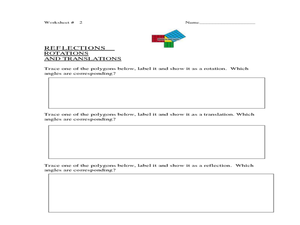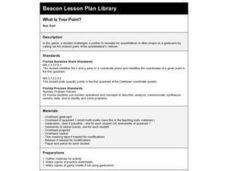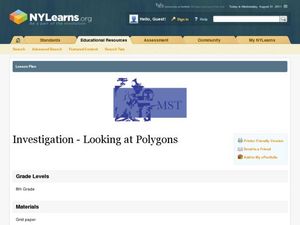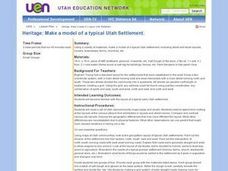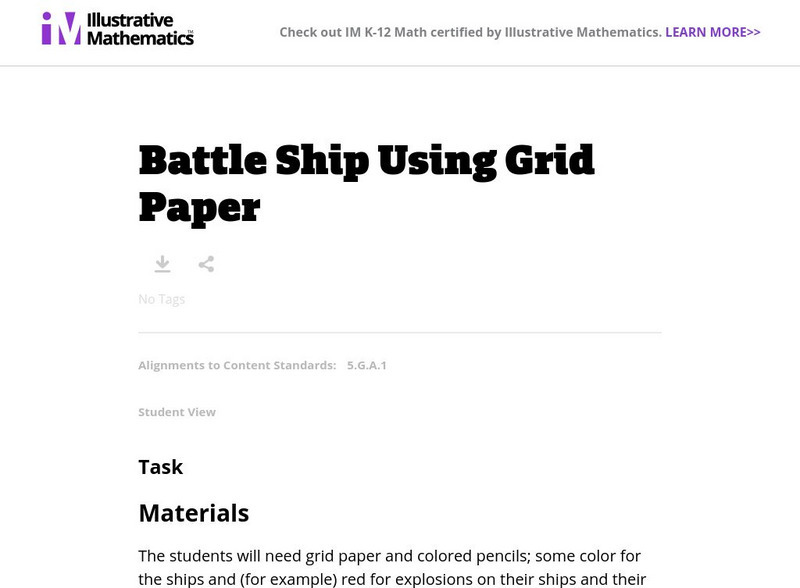Alabama Learning Exchange
Coordinate Geometry
Where do the coordinates lead? As children brainstorm ways to find the location of different buildings, they learn about coordinate points and how to use them to locate areas on a grid or map. They practice using ordered pairs by playing...
Curated OER
Point Comparisons
Young geometers investigate two-dimensional figures using coordinate grids. They identify polygons and draw examples of their reflection, rotation, and translation on a coordinate grid. And they complete a worksheet practicing examples...
Primary Resources
Coordinate Geometry
Introduce your fifth graders to the coordinate plane, ordered pairs, and plotting points on any of the four quadrants. This wonderful resource makes preparation for your math class quick and easy. It explains everything the class will...
Curated OER
Number Pairs
As you introduce graphs to young scholars, use this coordinate pairs activity to give them some independent practice. Learners examine 12 points on a graph, all of which are in the first quadrant (and therefore positive). They write the...
Curated OER
Coordinate Planes
Identifying the location of ordered pairs on coordinate planes is the focus in the math lesson presented here. In it, 4th graders are introduced to coordinate pairs, the x/y axis, and the techniques associated with this type of graphing....
Curated OER
Ordered Pairs
In this ordered pairs learning exercise, 10th graders solve and graph 6 different sets of points on each graph. First, they draw each of the given ordered pairs in each problem on the gird shown. Then, students label each of these points...
Curated OER
The Coordinate Plane
Fifth graders use the attached worksheet, Where's My Location? - Directions, to play a game in which they plot points on a grid.
Curated OER
Coordinate Geometry
Grab your class and get them graphing polygons on a coordinate plane! They investigate the four quadrants, discover the x and y axis, and correctly plot ordered pairs. To show their comprehension, each child creates a coordinate picture...
Curated OER
Twists and Turns
Students reflect, rotate, translate, and dilate figures in the Cartesian coordinate plane using grid paper and dot paper. They use transformations (i.e., reflections, translations, rotations, and dilations) to describe geometric patterns...
Curated OER
Investigation-Looking at Polygons
Eighth graders plot points and investigate polygons. They locate a point, using ordered pairs of integers on the coordinate plane. Students compare geometric measurements and computations on coordinate axes as they are applied to...
Curated OER
Scatter Brain
Examine a coordinated geometry grid to decode the hidden message. Pupils write a coded message to their parents using letter coordinates from the grid.
Curated OER
What Is Your Point?
Sixth graders identify the x and y axes in a coordinate plane and identifies the coordinates of a given point in the first quadrant. They plot specific points in the first quadrant of the Cartesian coordinate system.
Pennsylvania Department of Education
Tetrominoes and Translations
Young scholars explore geometry by participating in a pattern identification activity. In this tetrominoes lesson, students define the characteristics of congruent and symmetrical shapes. Young scholars practice translating shapes across...
Math Sphere
Co-Ordinates
Challenge young mathematicians' understanding of the coordinate plane with this series of skills practice worksheets. Offering 10 different exercises that involve identifying ordered pairs,...
Mathematics Assessment Project
Aaron's Designs
Learners first create designs for greeting cards by applying transformations of shapes on a coordinate plane, and then determine a sequence of transformations that produces a given design.
Curated OER
Where in the World? The Basics of Latitude and Longitude
Students are introduced to the concepts of latitude and longitude. In groups, they identify the Earth's magnetic field and the disadvantages of using compasses for navigation. They identify the major lines of latitude and longitude on a...
Curated OER
Baseball Challenge - Basic Geography Skills
A fabulous presentation/activity based on geography. The author has designed a "baseball game" where batters advance to the next base if they correctly answer a multiple choice question about geography. Geographic terms are used, along...
NY Learns
Investigation - Looking at Polygons
Middle schoolers construct polygons by plotting points on a coordinate plane. Pupils connect the points and identify which polygons they have drawn. They will need graph paper to carry out the assigned activities. A vocabulary list,...
Curated OER
Exponential Functions
In this algebra worksheet, students evaluate exponential functions using tables and graphs. There are 6 questions with an answer key.
Curated OER
Heritage: Make a Model of a Typical Utah Settlement
Fourth graders examine the different types of settlements used in Utah. They take a community map of Utah past and present and compare the two. They create a model of the early types of settlements used by pioneers in Utah.
Curated OER
Trigonometry Review
In this trigonometry worksheet, learners solve trigonometric equations, prove trigonometric identities, and graph trigonometric functions. The four page worksheet contains sixteen questions. Answers are not...
Curated OER
Spelling List 24: Sight Words, R-Controlled Vowels, and Academic Vocabulary
In this spelling list worksheet, students practice spelling words that are sight words, r controlled vowels, and vocabulary. Students practice spelling 21 words total.
Curated OER
Are You Coordinated?
First graders are introduced to a coordinate graph. They are given a graph and follow directions to place stickers in the designated blocks. They write coordinate points to identify the placement of their stickers.
Illustrative Mathematics
Illustrative Mathematics: 5.g Battle Ship Using Grid Paper
The purpose of this task is to give students practice plotting points in the first quadrant of the coordinate plane and naming coordinates of points. Aligns with 5.G.A.1.



